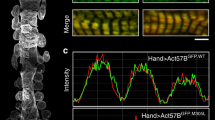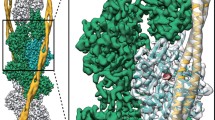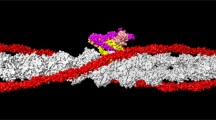Abstract
Tropomyosin (Tpm) is a two-chained α-helical coiled-coil protein that binds to filamentous actin (F-actin), and regulates its interactions with myosin by occupying three average positions on F-actin (blocked, closed, and open). Mutations in the Tpm are linked to heart diseases including hypertrophic cardiomyopathy (HCM) and dilated cardiomyopathy (DCM). To elucidate the molecular mechanisms of Tpm mutations (including DCM mutation E54K, HCM mutations E62Q, A63V, K70T, V95A, D175N, E180G, L185R, E192K, and a designed synthetic mutation D137L) in terms of their effects on Tpm flexibility and its interactions with F-actin, we conducted extensive molecular dynamics simulations for the wild-type and mutant Tpm in complex with F-actin (total simulation time 160 ns per mutant). The mutants exhibited distinct changes (i.e., increase or decrease) in the overall and local flexibility of the Tpm coiled-coil, with each mutation causing both local and long-range modifications of the Tpm flexibility. In addition, our binding calculations revealed weakened Tpm–F-actin interactions (except for L185R, D137L and A63V) involving five periods of Tpm, which correlate with elevated fluctuation of Tpm relative to the blocked position on F-actin that may lead to easier activation and increased Ca2+-sensitivity. We also simulated the αβ/βα-Tpm heterodimer in comparison with the αα-Tpm homodimer, which revealed greater flexibility and weaker actin binding in the heterodimer. Our findings are consistent with a complex mechanism underlying how different Tpm mutations perturb the Tpm function in distinct ways (e.g., by affecting specific sites of Tpm), which bear no simple links to the disease phenotypes (e.g., HCM vs. DCM).




Similar content being viewed by others
References
Bai F, Wang L, Kawai M (2013) A study of tropomyosin’s role in cardiac function and disease using thin-filament reconstituted myocardium. J Muscle Res Cell Motil 34:295–310. doi:10.1007/s10974-013-9343-z
Barua B, Pamula MC, Hitchcock-DeGregori SE (2011) Evolutionarily conserved surface residues constitute actin binding sites of tropomyosin. Proc Natl Acad Sci USA 108:10150–10155. doi:10.1073/pnas.1101221108
Barua B, Fagnant PM, Winkelmann DA, Trybus KM, Hitchcock-Degregori SE (2013) A periodic pattern of evolutionarily-conserved basic and acidic residues constitutes the binding interface of actin–tropomyosin. J Biol Chem 288:9602–9609. doi:10.1074/jbc.M113.451161
Behrmann E, Muller M, Penczek PA, Mannherz HG, Manstein DJ, Raunser S (2012) Structure of the rigor actin–tropomyosin–myosin complex. Cell 150:327–338. doi:10.1016/j.cell.2012.05.037
Bing W, Redwood CS, Purcell IF, Esposito G, Watkins H, Marston SB (1997) Effects of two hypertrophic cardiomyopathy mutations in alpha-tropomyosin, Asp175Asn and Glu180Gly, on Ca2+ regulation of thin filament motility. Biochem Biophys Res Commun 236:760–764. doi:10.1006/bbrc.1997.7045
Boussouf SE, Maytum R, Jaquet K, Geeves MA (2007) Role of tropomyosin isoforms in the calcium sensitivity of striated muscle thin filaments. J Muscle Res Cell Motil 28:49–58. doi:10.1007/s10974-007-9103-z
Brooks BR, Bruccoleri RE, Olafson BD, States DJ, Swaminathan S, Karplus M (1983) Charmm—a program for macromolecular energy minimization, and dynamics calculations. J Comput Chem 4:187–217
Brown JH (2010) How sequence directs bending in tropomyosin and other two-stranded alpha-helical coiled coils. Protein Sci 19:1366–1375. doi:10.1002/pro.415
Brown JH (2013) Deriving how far structural information is transmitted through parallel homodimeric coiled-coils: a correlation analysis of helical staggers. Proteins 81:635–643. doi:10.1002/prot.24218
Brown JH et al (2001) Deciphering the design of the tropomyosin molecule. Proc Natl Acad Sci USA 98:8496–8501. doi:10.1073/pnas.131219198
Brown JH, Zhou Z, Reshetnikova L, Robinson H, Yammani RD, Tobacman LS, Cohen C (2005) Structure of the mid-region of tropomyosin: bending and binding sites for actin. Proc Natl Acad Sci USA 102:18878–18883. doi:10.1073/pnas.0509269102
Caves LS, Evanseck JD, Karplus M (1998) Locally accessible conformations of proteins: multiple molecular dynamics simulations of crambin. Protein Sci 7:649–666. doi:10.1002/pro.5560070314
Chang AN, Harada K, Ackerman MJ, Potter JD (2005) Functional consequences of hypertrophic and dilated cardiomyopathy-causing mutations in alpha-tropomyosin. J Biol Chem 280:34343–34349. doi:10.1074/jbc.M505014200
Chang AN, Greenfield NJ, Singh A, Potter JD, Pinto JR (2014) Structural and protein interaction effects of hypertrophic and dilated cardiomyopathic mutations in alpha-tropomyosin. Front Physiol 5:460. doi:10.3389/fphys.2014.00460
Craig R, Lehman W (2001) Crossbridge and tropomyosin positions observed in native, interacting thick and thin filaments. J Mol Biol 311:1027–1036. doi:10.1006/jmbi.2001.4897
Deserno M, Holm C (1998) How to mesh up Ewald sums. I. A theoretical and numerical comparison of various particle mesh routines. J Chem Phys 109:7678–7693
Eriksson MA, Roux B (2002) Modeling the structure of agitoxin in complex with the Shaker K+ channel: a computational approach based on experimental distance restraints extracted from thermodynamic mutant cycles. Biophys J 83:2595–2609. doi:10.1016/S0006-3495(02)75270-3
Geeves MA, Hitchcock-DeGregori SE, Gunning PW (2015) A systematic nomenclature for mammalian tropomyosin isoforms. J Muscle Res Cell Motil 36:147–153. doi:10.1007/s10974-014-9389-6
Gilson MK, Honig BH (1986) The dielectric constant of a folded protein. Biopolymers 25:2097–2119. doi:10.1002/bip.360251106
Gilson MK, Honig BH (1988) Energetics of charge–charge interactions in proteins. Proteins 3:32–52. doi:10.1002/prot.340030104
Golitsina N et al (1997) Effects of two familial hypertrophic cardiomyopathy-causing mutations on alpha-tropomyosin structure and function. Biochemistry 36:4637–4642. doi:10.1021/bi962970y
Golitsina N et al (1999) Effects of two familial hypertrophic cardiomyopathy-causing mutations on alpha-tropomyosin structure and function. Biochemistry 38:3850. doi:10.1021/bi9950701
Gunning P (2008) Emerging issues for tropomyosin structure, regulation, function and pathology. Adv Exp Med Biol 644:293–298
Gupte TM et al (2015) Mechanistic heterogeneity in contractile properties of alpha-tropomyosin (TPM1) mutants associated with inherited cardiomyopathies. J Biol Chem 290:7003–7015. doi:10.1074/jbc.M114.596676
Heller MJ, Nili M, Homsher E, Tobacman LS (2003) Cardiomyopathic tropomyosin mutations that increase thin filament Ca2+ sensitivity and tropomyosin N-domain flexibility. J Biol Chem 278:41742–41748. doi:10.1074/jbc.M303408200
Hilario E, da Silva SL, Ramos CH, Bertolini MC (2004) Effects of cardiomyopathic mutations on the biochemical and biophysical properties of the human alpha-tropomyosin. Eur J Biochem 271:4132–4140. doi:10.1111/j.1432-1033.2004.04351.x
Hitchcock-DeGregori SE, Singh A (2010) What makes tropomyosin an actin binding protein? A perspective. J Struct Biol 170:319–324. doi:10.1016/j.jsb.2009.12.013
Hitchcock-DeGregori SE, Song Y, Moraczewska J (2001) Importance of internal regions and the overall length of tropomyosin for actin binding and regulatory function. Biochemistry 40:2104–2112
Holmes KC, Lehman W (2008) Gestalt-binding of tropomyosin to actin filaments. J Muscle Res Cell Motil 29:213–219. doi:10.1007/s10974-008-9157-6
Hoover WG (1985) Canonical dynamics—equilibrium phase-space distributions. Phys Rev A 31:1695–1697
Humphrey W, Dalke A, Schulten K (1996) VMD: visual molecular dynamics. J Mol Graph 14(33–38):27–38
Im W, Beglov D, Roux B (1998) Continuum solvation model: computation of electrostatic forces from numerical solutions to the Poisson–Boltzmann equation. Comput Phys Commun 111:59–75
Janco M, Kalyva A, Scellini B, Piroddi N, Tesi C, Poggesi C, Geeves MA (2012) alpha-Tropomyosin with a D175N or E180G mutation in only one chain differs from tropomyosin with mutations in both chains. Biochemistry 51:9880–9890. doi:10.1021/bi301323n
Jongbloed RJ, Marcelis CL, Doevendans PA, Schmeitz-Mulkens JM, Van Dockum WG, Geraedts JP, Smeets HJ (2003) Variable clinical manifestation of a novel missense mutation in the alpha-tropomyosin (TPM1) gene in familial hypertrophic cardiomyopathy. J Am Coll Cardiol 41:981–986
Kalyva A, Schmidtmann A, Geeves MA (2012) In vitro formation and characterization of the skeletal muscle alpha·beta tropomyosin heterodimers. Biochemistry 51:6388–6399. doi:10.1021/bi300340r
Karibe A et al (2001) Hypertrophic cardiomyopathy caused by a novel alpha-tropomyosin mutation (V95A) is associated with mild cardiac phenotype, abnormal calcium binding to troponin, abnormal myosin cycling, and poor prognosis. Circulation 103:65–71
Karplus M, McCammon JA (2002) Molecular dynamics simulations of biomolecules. Nat Struct Biol 9:646–652. doi:10.1038/nsb0902-646
Khaitlina SY (2015) Tropomyosin as a regulator of actin dynamics. Int Rev Cell Mol Biol 318:255–291. doi:10.1016/bs.ircmb.2015.06.002
Kremneva E, Boussouf S, Nikolaeva O, Maytum R, Geeves MA, Levitsky DI (2004) Effects of two familial hypertrophic cardiomyopathy mutations in alpha-tropomyosin, Asp175Asn and Glu180Gly, on the thermal unfolding of actin-bound tropomyosin. Biophys J 87:3922–3933. doi:10.1529/biophysj.104.048793
Kwok SC, Hodges RS (2004) Stabilizing and destabilizing clusters in the hydrophobic core of long two-stranded alpha-helical coiled-coils. J Biol Chem 279:21576–21588. doi:10.1074/jbc.M401074200
Lakkaraju SK, Hwang W (2009) Modulation of elasticity in functionally distinct domains of the tropomyosin coiled-coil. Cell Mol Bioeng 2:57–65. doi:10.1007/s12195-009-0050-1
Lehman W, Craig R (2008) Tropomyosin and the steric mechanism of muscle regulation. Adv Exp Med Biol 644:95–109
Lehman W, Li XE, Orzechowski M, Fischer S (2014) The structural dynamics of alpha-tropomyosin on F-actin shape the overlap complex between adjacent tropomyosin molecules. Arch Biochem Biophys 552–553:68–73. doi:10.1016/j.abb.2013.09.011
Li MH, Zheng WJ (2011) Probing the structural and energetic basis of kinesin-microtubule binding using computational alanine-scanning mutagenesis. Biochemistry 50:8645–8655. doi:10.1021/Bi2008257
Li M, Zheng W (2012) All-atom structural investigation of kinesin–microtubule complex constrained by high-quality cryo-electron-microscopy maps. Biochemistry 51:5022–5032. doi:10.1021/bi300362a
Li XE, Holmes KC, Lehman W, Jung H, Fischer S (2010a) The shape and flexibility of tropomyosin coiled coils: implications for actin filament assembly and regulation. J Mol Biol 395:327–339. doi:10.1016/j.jmb.2009.10.060
Li XE, Lehman W, Fischer S (2010b) The relationship between curvature, flexibility and persistence length in the tropomyosin coiled-coil. J Struct Biol 170:313–318. doi:10.1016/j.jsb.2010.01.016
Li XE, Lehman W, Fischer S, Holmes KC (2010c) Curvature variation along the tropomyosin molecule. J Struct Biol 170:307–312. doi:10.1016/j.jsb.2009.12.017
Li XE, Tobacman LS, Mun JY, Craig R, Fischer S, Lehman W (2011) Tropomyosin position on F-actin revealed by EM reconstruction and computational chemistry. Biophys J 100:1005–1013. doi:10.1016/j.bpj.2010.12.3697
Li XE, Suphamungmee W, Janco M, Geeves MA, Marston SB, Fischer S, Lehman W (2012) The flexibility of two tropomyosin mutants, D175N and E180G, that cause hypertrophic cardiomyopathy. Biochem Biophys Res Commun 424:493–496. doi:10.1016/j.bbrc.2012.06.141
Li XE, Orzechowski M, Lehman W, Fischer S (2014) Structure and flexibility of the tropomyosin overlap junction. Biochem Biophys Res Commun 446:304–308. doi:10.1016/j.bbrc.2014.02.097
Loong CK, Zhou HX, Chase PB (2012a) Familial hypertrophic cardiomyopathy related E180G mutation increases flexibility of human cardiac alpha-tropomyosin. FEBS Lett 586:3503–3507. doi:10.1016/j.febslet.2012.08.005
Loong CK, Zhou HX, Chase PB (2012b) Persistence length of human cardiac alpha-tropomyosin measured by single molecule direct probe microscopy. PLoS ONE 7:e39676. doi:10.1371/journal.pone.0039676
Lorenz M, Poole KJ, Popp D, Rosenbaum G, Holmes KC (1995) An atomic model of the unregulated thin filament obtained by X-ray fiber diffraction on oriented actin-tropomyosin gels. J Mol Biol 246:108–119. doi:10.1006/jmbi.1994.0070
Ly S, Lehrer SS (2012) Long-range effects of familial hypertrophic cardiomyopathy mutations E180G and D175N on the properties of tropomyosin. Biochemistry 51:6413–6420. doi:10.1021/bi3006835
MacKerell AD et al (1998) All-atom empirical potential for molecular modeling and dynamics studies of proteins. J Phys Chem B 102:3586–3616
Mackerell AD Jr, Feig M, Brooks CL 3rd (2004) Extending the treatment of backbone energetics in protein force fields: limitations of gas-phase quantum mechanics in reproducing protein conformational distributions in molecular dynamics simulations. J Comput Chem 25:1400–1415. doi:10.1002/jcc.20065
Marston SB (2011) How do mutations in contractile proteins cause the primary familial cardiomyopathies? J Cardiovasc Transl Res 4:245–255. doi:10.1007/s12265-011-9266-2
Marston S et al (2013) Mutations in repeating structural motifs of tropomyosin cause gain of function in skeletal muscle myopathy patients. Hum Mol Genet 22:4978–4987. doi:10.1093/hmg/ddt345
Marttila M et al (2012) Abnormal actin binding of aberrant beta-tropomyosins is a molecular cause of muscle weakness in TPM2-related nemaline and cap myopathy. Biochem J 442:231–239. doi:10.1042/BJ20111030
Martyna GJ, Hughes A, Tuckerman ME (1999) Molecular dynamics algorithms for path integrals at constant pressure. J Chem Phys 110:3275–3290
Matyushenko AM, Artemova NV, Sluchanko NN, Levitsky DI (2015) Effects of two stabilizing substitutions, D137L and G126R, in the middle part of alpha-tropomyosin on the domain structure of its molecule. Biophys Chem 196:77–85. doi:10.1016/j.bpc.2014.10.001
McKillop DF, Geeves MA (1993) Regulation of the interaction between actin and myosin subfragment 1: evidence for three states of the thin filament. Biophys J 65:693–701. doi:10.1016/S0006-3495(93)81110-X
McLachlan AD, Stewart M, Smillie LB (1975) Sequence repeats in alpha-tropomyosin. J Mol Biol 98:281–291
Michele DE, Coutu P, Metzger JM (2002) Divergent abnormal muscle relaxation by hypertrophic cardiomyopathy and nemaline myopathy mutant tropomyosins. Physiol Genomics 9:103–111. doi:10.1152/physiolgenomics.00099.2001
Mijailovich SM, Kayser-Herold O, Li X, Griffiths H, Geeves MA (2012) Cooperative regulation of myosin-S1 binding to actin filaments by a continuous flexible Tm–Tn chain. Eur Biophys J EBJ 41:1015–1032. doi:10.1007/s00249-012-0859-8
Minakata S, Maeda K, Oda N, Wakabayashi K, Nitanai Y, Maeda Y (2008) Two-crystal structures of tropomyosin C-terminal fragment 176-273: exposure of the hydrophobic core to the solvent destabilizes the tropomyosin molecule. Biophys J 95:710–719. doi:10.1529/biophysj.107.126144
Mirza M et al (2007) The effect of mutations in alpha-tropomyosin (E40K and E54K) that cause familial dilated cardiomyopathy on the regulatory mechanism of cardiac muscle thin filaments. J Biol Chem 282:13487–13497. doi:10.1074/jbc.M701071200
Moore JR, Li X, Nirody J, Fischer S, Lehman W (2011) Structural implications of conserved aspartate residues located in tropomyosin’s coiled-coil core. Bioarchitecture 1:250–255. doi:10.4161/bioa.18117
Muthuchamy M et al (1999) Mouse model of a familial hypertrophic cardiomyopathy mutation in alpha-tropomyosin manifests cardiac dysfunction. Circ Res 85:47–56
Nakajima-Taniguchi C, Matsui H, Nagata S, Kishimoto T, Yamauchi-Takihara K (1995) Novel missense mutation in alpha-tropomyosin gene found in Japanese patients with hypertrophic cardiomyopathy. J Mol Cell Cardiol 27:2053–2058
Nina M, Beglov D, Roux B (1997) Atomic radii for continuum electrostatics calculations based on molecular dynamics free energy simulations. J Phys Chem B 101:5239–5248
Olson MA, Reinke LT (2000) Modeling implicit reorganization in continuum descriptions of protein–protein interactions. Proteins 38:115–119. doi:10.1002/(SICI)1097-0134(20000101)38:1<115:AID-PROT11>3.0.CO;2-P
Orzechowski M, Fischer S, Moore JR, Lehman W, Farman GP (2014) Energy landscapes reveal the myopathic effects of tropomyosin mutations. Arch Biochem Biophys 564:89–99. doi:10.1016/j.abb.2014.09.007
Phillips GN Jr (1986) Construction of an atomic model for tropomyosin and implications for interactions with actin. J Mol Biol 192:128–131
Phillips GN Jr, Fillers JP, Cohen C (1986) Tropomyosin crystal structure and muscle regulation. J Mol Biol 192:111–131
Phillips JC et al (2005) Scalable molecular dynamics with NAMD. J Comput Chem 26:1781–1802. doi:10.1002/jcc.20289
Pirani A, Xu C, Hatch V, Craig R, Tobacman LS, Lehman W (2005) Single particle analysis of relaxed and activated muscle thin filaments. J Mol Biol 346:761–772. doi:10.1016/j.jmb.2004.12.013
Pirani A et al (2006) An atomic model of the thin filament in the relaxed and Ca2+-activated states. J Mol Biol 357:707–717. doi:10.1016/j.jmb.2005.12.050
Poole KJ et al (2006) A comparison of muscle thin filament models obtained from electron microscopy reconstructions and low-angle X-ray fibre diagrams from non-overlap muscle. J Struct Biol 155:273–284. doi:10.1016/j.jsb.2006.02.020
Prabhakar R, Boivin GP, Grupp IL, Hoit B, Arteaga G, Solaro RJ, Wieczorek DF (2001) A familial hypertrophic cardiomyopathy alpha-tropomyosin mutation causes severe cardiac hypertrophy and death in mice. J Mol Cell Cardiol 33:1815–1828. doi:10.1006/jmcc.2001.1445
Redwood C, Robinson P (2013) Alpha-tropomyosin mutations in inherited cardiomyopathies. J Muscle Res Cell Motil 34:285–294. doi:10.1007/s10974-013-9358-5
Roux B (1997) Influence of the membrane potential on the free energy of an intrinsic protein. Biophys J 73:2980–2989. doi:10.1016/S0006-3495(97)78327-9
Rynkiewicz MJ, Schott V, Orzechowski M, Lehman W, Fischer S (2015) Electrostatic interaction map reveals a new binding position for tropomyosin on F-actin. J Muscle Res Cell Motil. doi:10.1007/s10974-015-9419-z
Sharp KA, Honig B (1990a) Calculating total electrostatic energies with the nonlinear Poisson–Boltzmann equation. J Phys Chem 94:7684–7692
Sharp KA, Honig B (1990b) Electrostatic interactions in macromolecules: theory and applications. Annu Rev Biophys Biophys Chem 19:301–332. doi:10.1146/annurev.bb.19.060190.001505
Singh A, Hitchcock-DeGregori SE (2006) Dual requirement for flexibility and specificity for binding of the coiled-coil tropomyosin to its target, actin. Structure 14:43–50. doi:10.1016/j.str.2005.09.016
Sousa D, Cammarato A, Jang K, Graceffa P, Tobacman LS, Li XE, Lehman W (2010) Electron microscopy and persistence length analysis of semi-rigid smooth muscle tropomyosin strands. Biophys J 99:862–868. doi:10.1016/j.bpj.2010.05.004
Sousa DR, Stagg SM, Stroupe ME (2013) Cryo-EM structures of the actin: tropomyosin filament reveal the mechanism for the transition from C- to M-state. J Mol Biol 425:4544–4555. doi:10.1016/j.jmb.2013.08.020
Stone JE, Hardy DJ, Ufimtsev IS, Schulten K (2010) GPU-accelerated molecular modeling coming of age. J Mol Graph Model 29:116–125. doi:10.1016/j.jmgm.2010.06.010
Sumida JP, Wu E, Lehrer SS (2008) Conserved Asp-137 imparts flexibility to tropomyosin and affects function. J Biol Chem 283:6728–6734. doi:10.1074/jbc.M707485200
Van Driest SL, Will ML, Atkins DL, Ackerman MJ (2002) A novel TPM1 mutation in a family with hypertrophic cardiomyopathy and sudden cardiac death in childhood. Am J Cardiol 90:1123–1127
Vibert P, Craig R, Lehman W (1997) Steric-model for activation of muscle thin filaments. J Mol Biol 266:8–14. doi:10.1006/jmbi.1996.0800
von der Ecken J, Muller M, Lehman W, Manstein DJ, Penczek PA, Raunser S (2015) Structure of the F-actin–tropomyosin complex. Nature 519:114–117. doi:10.1038/nature14033
Wang F et al (2011) Facilitated cross-bridge interactions with thin filaments by familial hypertrophic cardiomyopathy mutations in alpha-tropomyosin. J Biomed Biotechnol 2011:435271. doi:10.1155/2011/435271
Yamauchi-Takihara K, Nakajima-Taniguchi C, Matsui H, Fujio Y, Kunisada K, Nagata S, Kishimoto T (1996) Clinical implications of hypertrophic cardiomyopathy associated with mutations in the alpha-tropomyosin gene. Heart 76:63–65
Yar S et al (2013) Conserved Asp-137 is important for both structure and regulatory functions of cardiac alpha-tropomyosin (alpha-TM) in a novel transgenic mouse model expressing alpha-TM-D137L. J Biol Chem 288:16235–16246. doi:10.1074/jbc.M113.458695
Yuen M et al (2015) Muscle weakness in TPM3-myopathy is due to reduced Ca2+-sensitivity and impaired acto-myosin cross-bridge cycling in slow fibres. Hum Mol Genet 24:6278–6292. doi:10.1093/hmg/ddv334
Zheng X, Diraviyam K, Sept D (2007) Nucleotide effects on the structure and dynamics of actin. Biophys J 93:1277–1283. doi:10.1529/biophysj.107.109215
Zheng W, Barua B, Hitchcock-DeGregori SE (2013) Probing the flexibility of tropomyosin and its binding to filamentous actin using molecular dynamics simulations. Biophys J 105:1882–1892. doi:10.1016/j.bpj.2013.09.003
Acknowledgments
We thank funding support from American Heart Association (#14GRNT18980033) and National Science Foundation (#0952736) to WZ, and National Institutes of Health (GM093065) to SEHD and BB. We thank Dr. Lehman for sharing the EM-based model of Tpm–F-actin complex. The simulations were conducted using the supercomputing cluster of the Center for Computational Research at the University at Buffalo and the Biowulf cluster at the National Institutes of Health.
Author information
Authors and Affiliations
Corresponding author
Electronic supplementary material
Below is the link to the electronic supplementary material.
Rights and permissions
About this article
Cite this article
Zheng, W., Hitchcock-DeGregori, S.E. & Barua, B. Investigating the effects of tropomyosin mutations on its flexibility and interactions with filamentous actin using molecular dynamics simulation. J Muscle Res Cell Motil 37, 131–147 (2016). https://doi.org/10.1007/s10974-016-9447-3
Received:
Accepted:
Published:
Issue Date:
DOI: https://doi.org/10.1007/s10974-016-9447-3




